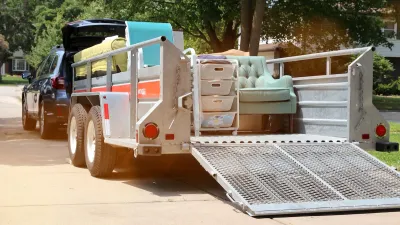The false dichotomy of rich cities and poor suburbs is reductive and damaging.

The rebound of the American city has been exaggerated, according to a story by Joe Cortright in City Observatory. While it's true that "inner cities" can't be called "a disaster.. in every possible way," it's just as true that they aren't all glittering "playgrounds of the rich." Cortright cautions: "As a description of the direction of change, these stories are right: many city neighborhoods are attracting more better-educated and higher-income residents," it also needs to be said that "the narrative of 'rich cities, poor suburbs' represents a vast overstatement of the scale of these changes," according to Cortright.
Furthermore, it's easy to manage the numbers to exaggerate the trend, looking at the case of a Brookings Institution report, Cortright found serious issues: "Dividing all urban space into just two categories (city and suburb) and reporting totals for each makes it seem like poverty is somehow increasing and evenly spread in every suburb. But that’s not true. Some poor suburbs are the older, first tier towns just outside the larger central city." He cites Hoboken, New Jersey and East Hartford, Connecticut as older cities, classified in Brookings study as suburbs.
The "so what" of all this change in cities is that it poses a real opportunity. Not for planners and urbanists to pat themselves on the backs for bringing people back to cities, but "to invest in city neighborhoods, commit to city schools, and exercise citizenship, there’s a huge opportunity to leverage this momentum to address the city’s poverty and segregation problems."
FULL STORY: The new mythology of rich cities and poor suburbs

Planetizen Federal Action Tracker
A weekly monitor of how Trump’s orders and actions are impacting planners and planning in America.

San Francisco's School District Spent $105M To Build Affordable Housing for Teachers — And That's Just the Beginning
SFUSD joins a growing list of school districts using their land holdings to address housing affordability challenges faced by their own employees.

The Tiny, Adorable $7,000 Car Turning Japan Onto EVs
The single seat Mibot charges from a regular plug as quickly as an iPad, and is about half the price of an average EV.

San Diego Votes to Rein in “Towering” ADUs
City council voted to limit the number of units in accessory buildings to six — after confronting backyard developments of up to 100 units behind a single family home.

Texas Legislature’s Surprising Pro-Housing Swing
Smaller homes on smaller lots, office to apartment conversions, and 40% less say for NIMBYs, vote state lawmakers.

Even Edmonton Wants Single Staircase Buildings
Canada's second most affordable major city joins those angling to nix the requirement for two staircases in multi-family buildings.
Urban Design for Planners 1: Software Tools
This six-course series explores essential urban design concepts using open source software and equips planners with the tools they need to participate fully in the urban design process.
Planning for Universal Design
Learn the tools for implementing Universal Design in planning regulations.
Borough of Carlisle
Smith Gee Studio
City of Camden Redevelopment Agency
City of Astoria
Transportation Research & Education Center (TREC) at Portland State University
City of Camden Redevelopment Agency
Municipality of Princeton (NJ)




























